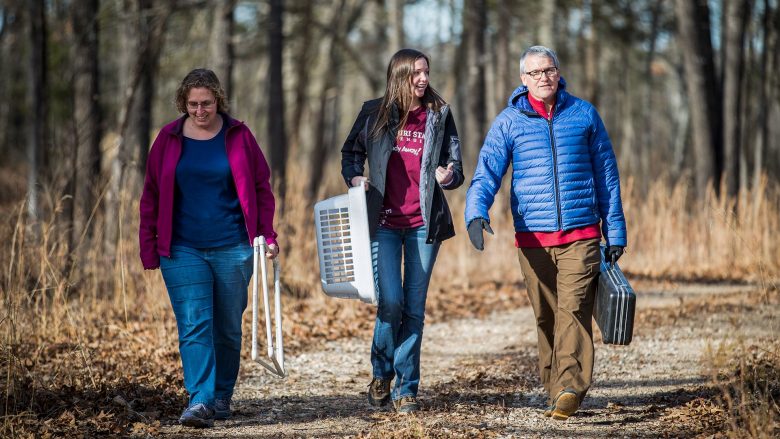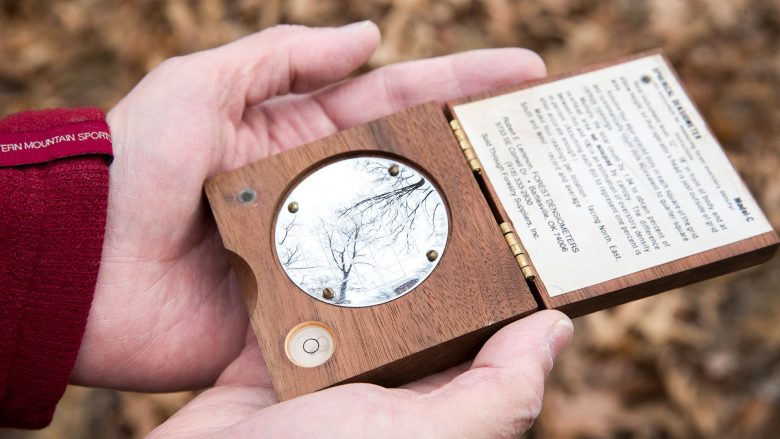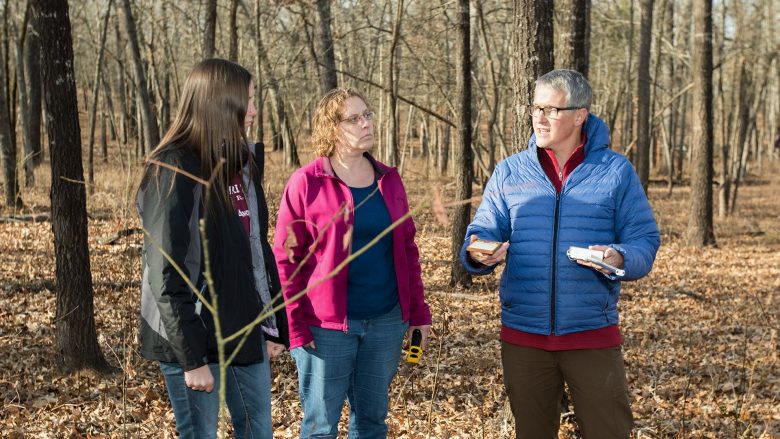Read the leaves: How plants respond to the world
Wait, professor of biology, studies how plants respond to environmental variation. It’s been his focus for 20 years.
“We learn about how fire, temperature and light affect physiological processes – like photosynthesis,” said Wait. “And ultimately we can show how multiple factors affect not just this tree, but an entire forest or the whole ecosystem.”

Photo by Kevin White
Nanoparticles
His research team investigates many variables that affect plant growth. He said, at its core, the research is important because plants are the base of all terrestrial food chains.
Usually when I’m coming into a project, it’s because somebody wants to know the why.
For example, 25 percent of all consumer products now contain materials referred to as engineered nanomaterials, ENMs. So in 2013, Wait joined other faculty from Missouri State University’s College of Natural and Applied Sciences to develop the Carbon Nanotube Life Cycle Working Group.
One of his collaborators is Dr. Laszlo Kovacs, geneticist and biology professor. They are investigating how nanoparticles – which will enter systems through the landfills or when washed down the drain – may be toxic to plants and insects.
“While these materials may have been proven safe as integrated components of electronics, cosmetics or clothing, their physicochemical characteristics change when they are released to the environment,” said Kovacs. “Their safety to plants, animals and microbes may not be guaranteed any longer.”
Wait notes that insurance companies are driving this need to know.

Photo by Chris Nagle
Mustard and moths
To understand the impact, Wait and Kovacs used Arabidopsis, a plant in the mustard family that is commonly used in plant genetic and physiological research. They grew the plants in media containing engineered carbon nanotubes.
Then Wait measured the plants’ physiological responses using a gas exchange system. He tested to discover if the ENMs caused an imbalance in the plants’ carbon and nitrogen ratio, whether the stomates closed up (making photosynthesis impossible) or otherwise affected a plant’s physiology.
In the gas exchange chamber, which mimics the exact environmental conditions of the growth chamber, the plants showed only minimal signs of reduced photosynthesis and growth from engineered carbon nanoparticles.
“I measure the plants’ photosynthetic rates. Then I change the light carbon dioxide concentration and elucidate the mechanisms affecting photosynthesis,” said Wait.
Then Wait studied how diamondback moths are affected by directly feeding on the ENMs or how they were affected when exposed to the Arabidopsis grown in the nanoparticles.
The carbon nanotubes didn’t deter the insects from the food – Arabidopsis is the feast of choice for this type of moth – and didn’t kill them either. Wait noted that the moths continued to go through metamorphosis and grow into adults.
But the moths’ reproductive abilities were reduced by 50 percent. Also, the moths ate more but weren’t growing as well due to diminished food quality.
The entire genome of both the Arabidopsis and diamondback moth have been sequenced, which means Wait and Kovacs were able to identify how genes were affected by the exposure.
“We expect to identify a set of genes that change their expression when the plants are exposed to engineered nanomaterials,” Kovacs added, “and at what concentrations these ENMs are harmful to plants.”

Photo by Kevin White
Setting the standard
Previous studies of how these nanoparticles decompose and affect plants have yielded inconsistent results.
“There was a study that showed that if you put carbon nanotubes in the soil, you could increase the size of a melon like 20 or 30 percent. Others have shown that it’s toxic at the seedling stage, but the concentrations vary a lot,” said Wait.
Wait hopes their experiments establish a standard protocol for evaluating toxicity. He and Kovacs are writing standard operating procedures for screening nanoparticles for the U.S. Army Corps of Engineers. Wait has had three graduate students complete theses on this research, and they are in the process of submitting their research results to scientific journals.

Photo by Kevin White
The silver tests
Now, Wait and Kovacs are conducting similar experiments using silver nanotubes, which are often found in antibiotics.
Even in the early stages of the experiment, it was obvious the silver nanotubes were having a much more detrimental impact and turning on and off genes in the plant and moth.
“The silver nanotubes are found in antibiotics and silver kills bacteria, which is good,” said Wait. “We’re trying to find out at what concentration consumption is affected? Growth? Does it affect pupation? Does it affect survivorship?”
With an estimated 100,000 tons of waste in the landfill containing nanomaterials, this research of engineered nanoparticles in the environment is growing in importance.
“It is not only important to know that products are safe during their service life to consumers,” said Kovacs, “but that they are safe after they are disposed or released to the environment.”
- Story by Nicki Donnelson
- Main photo by Kevin White
- Video by Chris Nagle

